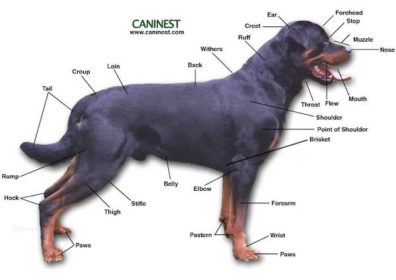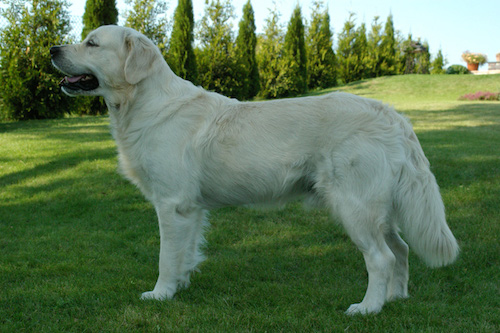
The picture of the Rottweiler (taken from http://www.caninest.com/) shows something we want you to notice – the dog’s “top line.” It’s what we would call appropriately level, appropriate because that’s what the breed standard call for: The back is firm and level, extending in a straight line from behind the withers to the croup.
More to the point, this dog is not “high in the rear.”
A dog that is “high in the rear” looks like what the term describes. The dog’s rump is as high, or higher, than the highest point of the dog’s shoulders behind his neck (his withers – look at the picture to find it).
The Golden Retriever seen in the photograph below (taken from Wikimedia Commons, the free media repository, and attributed to Monika Mężyńska – Own work, CC BY-SA 2.5, https://commons.wikimedia.org/w/index.php?curid=1677187) is slightly high in the rear, not what its AKC standard wants: Strong and level from withers to slightly sloping croup, whether standing or moving.
Some breed standards call for the dog to be higher in the rear. The Chesapeake Bay Retriever‘s topline should show the hindquarters to be as high as or a trifle higher than the shoulders. Our understanding that this is because the breed’s hindquarters are powerfully built which enable the dog to swim even through chunks of ice floating in the water.
The Old English Sheepdog is another breed in which the rear appears bit higher, but this is because an OES stands lower at the withers than at the loin. This distinguishing characteristic of the breed is due to a group of muscles that extend and rise covering the loin, and then blend into a dog’s rounded muscular hindquarters. It’s the muscular loin that creates a correct OES topline.
Being “high in the rear” is a problem, however, in breeds where it’s not required. Why is it a problem for a dog that will never enter a show ring or rarely leaves the yard?
Because being high in the rear puts more stress on the front end of the dog. This makes jumping much harder not only because there’s more pressure on the dog’s joints when landing a jump, but also because the dog has to work harder to lift up his front end to get over that jump. A high rear causes the hind legs to be more “under” the dog, and that diminishes the power from his back end to take off for a jump. This will impact a dog running an agility course, or trotting along side your bicycle for a fun weekend ride. After a while, the ride will be fun only for one of you.
Take note that we’re not talking about developing puppies; Some youngsters grow “unevenly, and if the pup’s rear leg assembly grows disproportionately, a puppy that’s ‘high in the rear’ usually outgrows it.
Structure matters. It’s not just for show dogs, it’s for every dog who wants to live an active, healthy life. What should you do if your dog is high in the rear? Simple. Love your dog, spoil him or her rotten, and enjoy his company. Just be mindful that there may be things you shouldn’t ask your dog to do not because he won’t do it, but because he will, even if it causes him pain.


Sorry, but your definition of level and mine are ‘way off. The Rottweiler in the picture has a nice straight line of a back, but it is not ‘level’, it clearly slopes downward from the withers to the croup. If the dog was a table, for example, a ball placed on the dog’s back would roll off, rather than resting in place. It does not have the rise in the loin as you describe for the OES, which would disrupt a smooth line, but it still isn’t ‘level’. Once again, breed term usage needs to be interpreted through looking at the breed itself.
Thanks for your input, Rillian!
I think you missed the appropriately level called for by the breeds standard part.
There are two dogs pictured in the post, and one of them, the Rottie, is the breed with the standard calling for an appropriately level topline. We assume you don’t feel the Rottie in the photo has an appropriately level topline? Perhaps you can share with us a photo of Rottweiler you feel has a better topline? Full credit given if we use it (and we’d need consent).
I think he is placing the ball at the point of the withers. Level starts and the base of the wither. To croup.. dog looks level to me..perhaps his dog has a straight shoulder?